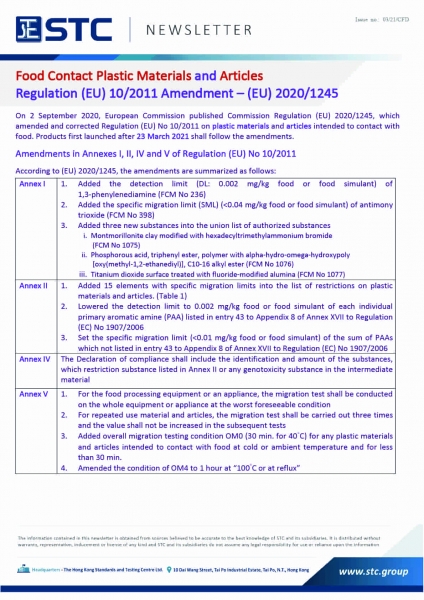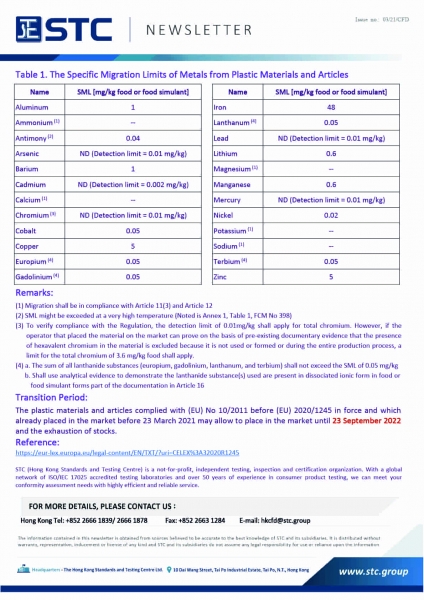
Food Contact Plastic Materials and Articles Regulation (EU) 10/2011 Amendment – (EU) 2020/1245
On 2 September 2020, European Commission published Commission Regulation (EU) 2020/1245, which amended and corrected Regulation (EU) No 10/2011 on plastic materials and articles intended to contact with food. Products first launched after 23 March 2021 shall follow the amendments.
Amendments in Annexes I, II, IV and V of Regulation (EU) No 10/2011
According to (EU) 2020/1245, the amendments are summarized as follows:
| Annex I |
1. Added the detection limit (DL: 0.002 mg/kg food or food simulant) of 1,3-phenylenediamine (FCM No 236)
2. Added the specific migration limit (SML) (<0.04 mg/kg food or food simulant) of antimony trioxide (FCM No 398)
3. Added three new substances into the union list of authorized substances i. Montmorillonite clay modified with hexadecyltrimethylammonium bromide (FCM No 1075)
ii. Phosphorous acid, triphenyl ester, polymer with alpha-hydro-omega-hydroxypoly [oxy(methyl-1,2-ethanediyl)], C10-16 alkyl ester (FCM No 1076)
iii. Titanium dioxide surface treated with fluoride-modified alumina (FCM No 1077) |
| Annex II |
1. Added 15 elements with specific migration limits into the list of restrictions on plastic materials and articles. (Table 1)
2. Lowered the detection limit to 0.002 mg/kg food or food simulant of each individual primary aromatic amine (PAA) listed in entry 43 to Appendix 8 of Annex XVII to Regulation (EC) No 1907/2006
3. Set the specific migration limit (<0.01 mg/kg food or food simulant) of the sum of PAAs which not listed in entry 43 to Appendix 8 of Annex XVII to Regulation (EC) No 1907/2006 |
| Annex IV | The Declaration of compliance shall include the identification and amount of the substances, which restriction substance listed in Annex II or any genotoxicity substance in the intermediate material |
| Annex V |
1. For the food processing equipment or an appliance, the migration test shall be conducted on the whole equipment or appliance at the worst foreseeable condition
2. For repeated use material and articles, the migration test shall be carried out three times and the value shall not be increased in the subsequent tests
3. Added overall migration testing condition OM0 (30 min. for 40°C) for any plastic materials and articles intended to contact with food at cold or ambient temperature and for less than 30 min.
4. Amended the condition of OM4 to 1 hour at “100°C or at reflux” |
Table 1. The Specific Migration Limits of Metals from Plastic Materials and Articles
| Name | SML [mg/kg food or food simulant] |
| Aluminum | 1 |
| Ammonium(1) | -- |
| Antimony(2) | 0.04 |
| Arsenic | ND (Detection limit = 0.01 mg/kg) |
| Barium | 1 |
| Cadmium | ND (Detection limit = 0.002 mg/kg) |
| Calcium(1) | -- |
| Chromium(3) | ND (Detection limit = 0.01 mg/kg) |
| Cobalt | 0.05 |
| Copper | 5 |
| Europium(4) | 0.05 |
| Gadolinium(4) | 0.05 |
| Iron | 48 |
| Lanthanum(4) | 0.05 |
| Lead | ND (Detection limit = 0.01 mg/kg) |
| Lithium | 0.6 |
| Magnesium(1) | -- |
| Manganese | 0.6 |
| Mercury | ND (Detection limit = 0.01 mg/kg) |
| Nickel | 0.02 |
| Potassium(1) | -- |
| Sodium(1) | -- |
| Terbium(4) | 0.05 |
| Zinc | 5 |
Remarks:
(1) Migration shall be in compliance with Article 11(3) and Article 12
(2) SML might be exceeded at a very high temperature (Noted is Annex 1, Table 1, FCM No 398)
(3) To verify compliance with the Regulation, the detection limit of 0.01mg/kg shall apply for total chromium. However, if the operator that placed the material on the market can prove on the basis of pre-existing documentary evidence that the presence of hexavalent chromium in the material is excluded because it is not used or formed or during the entire production process, a limit for the total chromium of 3.6 mg/kg food shall apply.
(4) a. The sum of all lanthanide substances (europium, gadolinium, lanthanum, and terbium) shall not exceed the SML of 0.05 mg/kg
b. Shall use analytical evidence to demonstrate the lanthanide substance(s) used are present in dissociated ionic form in food or food simulant forms part of the documentation in Article 16
Transition Period:
The plastic materials and articles complied with (EU) No 10/2011 before (EU) 2020/1245 in force and which already placed in the market before 23 March 2021 may allow to place in the market until 23 September 2022 and the exhaustion of stocks.
Reference:
https://eur-lex.europa.eu/legal-content/EN/TXT/?uri=CELEX%3A32020R1245
[See PDF version for more information]











